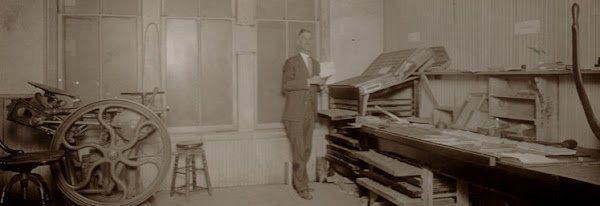
Old photographs and engravings conjure up feelings of nostalgia, historical interest, and rank curiosity. And they can often be a source of a surprising amount of practical information about the past, information that helps one gain real insight that goes beyond the superficial objects seen in the image. If we looks closely and carefully and where necessary take the time to do a little research to truly understand the snapshot of time that has been immortalized, we can make a tangible connection with those who have gone before us. Such a connection will enlighten our modern experiences and place them within a context in which their true meaning and worth can be grasped. Further, such an interaction with the past will give greater pleasure and satisfaction in those activities in which we take part in the present.
Take the above image as an example. It shows the press room of The Pictorial Drawing Room Companion circa 1858. Let's look at some of the things we can learn from this image that can help us understand better what the printing trade, the workplace, and society in general was like at that time.
First is the obvious. Even at this early date cylinder presses were actively at work. Even more so, the plant was steam-powered. Note the steam engine at the right which powered the presses. This place was very modern and they are making a point of letting people know it. Did you ever notice that pre-twentieth century factory buildings are long and narrow? This image shows why. Whether powered by water, steam, or later even electricity, machinery did not begin to have dedicated motors until the beginning of the twentieth century. Even then it took years for industry to fully change over. The single source of power must be distributed to the individual machines and this was accomplished by the line-shaft system as the image illustrates. The water wheel, steam engine, or whatever was connected to a main shaft that ran the length of the building. Because the machines, often different, had to be run at certain speeds, intermediate shafts with pulleys of different diameters were used to mechanically change the speed of the main shaft and deliver the correct speed to any given machine. The use of the line shaft dictated the architecture of the building. But it did even more.
These shafts were mounted to the ceiling and sometimes to the floor, by cast iron hangers in which were mounted bearings of a composition metal that was soft enough not to mar the steel shafts, hard enough to last many years, and that could be lubricated with oil and so allow the minimum of friction so the shafts could rotate freely. These were, and still are, the famous babbitt bearings, named for the inventor of the metal Isaac Babbitt. These bearings must have a regular supply of oil or friction will cause them to heat up, turn slower and even bind, causing damage and costly repairs.
Have you ever heard of grease monkeys? Ever wonder where that term came from? The means by which these bearings were kept oiled was through the labor of young boys who would climb into the rafters on a daily basis and oil each bearing. While the machines were running. And boys they were, even 9 and 10 year-olds. Why young boys? Their small size was an obvious advantage in tight quarters as was the small wage they could be paid. By the time they reached their early teens of course, they could start operating the machinery itself and start to really learn the trade. They're not seen in this image, but they and the social mores of the times are present nonetheless. Think of your 10 year old son going to work down at the steam-powered printing house every day for at least part of the day, including Saturdays, coming home all dirty like his father does from his own job. He gives you or perhaps his father his small wage every payday, helping meet the household expenses. Think of him climbing around, through, and over the moving shafts, pulleys, and machines, the flapping belts, 15 or 20 feet off the ground as he squirts oil into the small holes of the bearings. Are you getting a better understanding of the people and their lives at the time that image was printed?
Another interesting social aspect is in fact on view. Who do you see feeding the presses? Could it be...yes I think it is...women! This shouldn't really be a surprise, especially to letterpress printers who know even a little about the history of the craft. Women have long been associated with working presses. What makes this example a bit more interesting is that this is not a small family print shop or a forlorn western newspaper. Clearly they are well established working women in a large, for that time, printing operation employing dozens of workers at least. Just another day of work for the ladies of 1858. Eat your heart out, Rosie the Riveter.
There are any number of other things that can be gleaned from the now long forgotten steam-powered press room of the Pictorial Drawing Room Companion. See how many more you can spot for yourself. Get a feel for yesteryear that will help you understand tomorrow. Or today.













